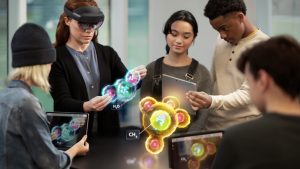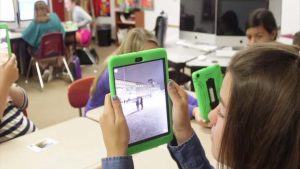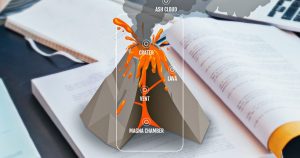
As technology continues to evolve, the educational landscape is witnessing significant changes. One of the most impactful technologies making its way into classrooms today is augmented reality (AR). Unlike virtual reality (VR), which immerses users in a completely digital environment, AR overlays digital information onto the physical world, creating interactive and immersive learning experiences. For educators and students, AR opens up new possibilities for learning by making complex topics more engaging and accessible.
What is Augmented Reality in Education?

Augmented reality in education refers to the use of digital content—such as 3D models, videos, sounds, and other visuals—that enhances real-world learning environments. AR uses devices like tablets, smartphones, or AR headsets to overlay interactive digital elements on physical objects or locations. This creates a blended learning experience that helps students understand concepts in a tangible, hands-on way. Unlike traditional textbooks or lectures, AR creates a dynamic learning process that appeals to different learning styles and keeps students engaged.
The Benefits of AR in Education
-
Enhanced Engagement and Motivation
- AR’s immersive and interactive features capture students’ attention by making learning more engaging. Subjects that students may find challenging or dry, like history or science, become more intriguing through AR. By visualizing and interacting with educational content, students become active participants in the learning process.
- Example: AR-based apps for biology allow students to explore the human body in 3D, examining organs, bones, and tissues in a way that feels lifelike and engaging.
-
Better Retention and Understanding
- Studies have shown that students who use AR tend to retain information longer than those who rely on traditional learning methods. This is because AR facilitates deeper learning, where complex concepts are broken down into visual and interactive elements that are easier to understand and recall.
- Case Study: A study conducted by Harvard University revealed that students using AR in STEM subjects retained 30% more information than those who did not use AR. Interactive visualization tools helped students understand abstract concepts and retain information more effectively.
-
Personalized Learning Experiences
- AR allows for personalized learning paths, making it easier for students to learn at their own pace and in a way that suits their learning style. For example, AR apps can adjust the level of complexity based on a student’s progress, ensuring that they master each concept before moving forward.
- Example: Educational AR apps, like CoSpaces Edu, provide content that adjusts to each student’s level of understanding, helping them tackle difficult subjects by offering step-by-step assistance.
-
Cost-Effective Access to Real-World Simulations
- AR provides an affordable way to create virtual simulations that mimic real-world scenarios. This is particularly useful in subjects like science, where lab experiments might be costly, or in geography, where students can “visit” historical sites without leaving the classroom.
- Example: Chemistry AR applications enable students to conduct experiments virtually. This not only eliminates the costs of physical materials but also provides a safer environment for experiments that may involve hazardous chemicals.
Popular Applications and Tools for AR in Education

-
Google Expeditions
- Google Expeditions is a well-known AR tool that offers immersive virtual field trips, enabling students to explore far-off places, historical landmarks, and scientific wonders in 3D. Students can roam ancient ruins, take underwater dives, and even venture to outer space, all from the classroom.
- Example: A history teacher may use Google Expeditions to take students on a tour of the Roman Colosseum, bringing historical lessons to life.
-
Merge Cube
- Merge Cube is a handheld device that works with AR apps to create interactive learning experiences. It allows students to hold and manipulate 3D objects in their hands, providing a unique tactile learning experience.
- Example: With Merge Cube, students studying geology can examine 3D models of rocks and minerals, helping them understand the physical properties of each type.
-
ClassVR
- ClassVR is a platform designed for K-12 classrooms, offering a wide range of AR and VR content aligned with curriculum standards. Teachers can tailor lessons using ClassVR’s resources, which include everything from biology models to historical artifacts.
- Example: ClassVR’s interactive curriculum allows students to explore the solar system, examining each planet’s characteristics and positioning, making science lessons more immersive.
Case Studies: AR in Action in Educational Institutions
-
Medical Education at Stanford University
- Stanford’s medical school has integrated AR into its curriculum for anatomy and surgical training. With AR headsets, medical students can interact with 3D models of the human body, viewing internal structures like muscles, nerves, and organs.
- Benefit: AR provides medical students with a hands-on experience that was previously limited to cadaver labs. By using 3D anatomy models, students can practice repeatedly without restrictions, gaining a thorough understanding of human anatomy.
-
History Lessons at Brooklyn School District
- In Brooklyn’s elementary school district, AR is used in history classes to bring ancient civilizations to life. Students use tablets to scan markers in textbooks, which then display 3D images of ancient architecture, artifacts, and landscapes.
- Benefit: AR allows students to “time travel,” gaining a visual understanding of historical events, cultures, and locations that would be challenging to convey through textbooks alone.
-
Science Experiments at Global Tech High School
- At Global Tech High School, AR helps students in low-resource areas conduct simulated experiments in physics and chemistry. With AR apps, students can observe chemical reactions, measure forces, and explore the principles of energy and motion.
- Benefit: For schools with limited lab facilities, AR provides an affordable and safe way for students to conduct experiments. This promotes hands-on learning without the constraints of physical resources.
Challenges and Considerations of Using AR in Education

-
High Implementation Costs
- Although AR offers many educational benefits, the initial cost of implementing AR technology can be a barrier. Schools need to invest in AR-compatible devices and software, which may not be feasible for low-budget institutions.
-
Technical and Operational Training
- Teachers require training to integrate AR effectively into their curriculum. Without proper training, educators may struggle to use AR tools to their fullest potential, limiting the benefits for students.
-
Data Privacy and Security Concerns
- Many AR applications collect data to personalize learning experiences, raising privacy concerns. Schools and educators must ensure that any AR software used complies with data privacy regulations to protect students’ information.
Future Trends of AR in Education
-
Increasing Accessibility and Affordability
- As technology advances, the cost of AR devices is likely to decrease, making AR more accessible to schools across different socioeconomic backgrounds. Tech companies are also developing affordable AR platforms for education to bridge the digital divide.
-
AR-Powered Virtual Classrooms
- In the future, AR may support virtual classrooms where students from around the world can interact in a shared augmented space. This would provide unprecedented opportunities for global collaboration and cultural exchange.
-
Collaboration with AI for Customized Content
- By integrating AR with artificial intelligence, future educational tools will offer increasingly customized experiences. AI can analyze student performance and adapt AR content to provide a personalized learning journey that meets each student’s needs.
Conclusion
Augmented reality has the potential to revolutionize education by making learning interactive, engaging, and accessible. From improving retention rates to creating personalized learning experiences, AR addresses many challenges faced by traditional education systems. Despite the initial investment, AR has proven to be a powerful tool that can transform classrooms and prepare students for a technology-driven world. As AR becomes more affordable and widely adopted, it is set to become an integral part of modern education, making learning more immersive and impactful for future generations.










